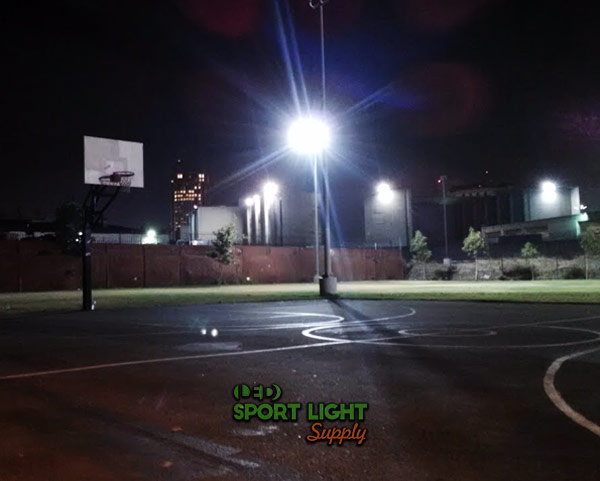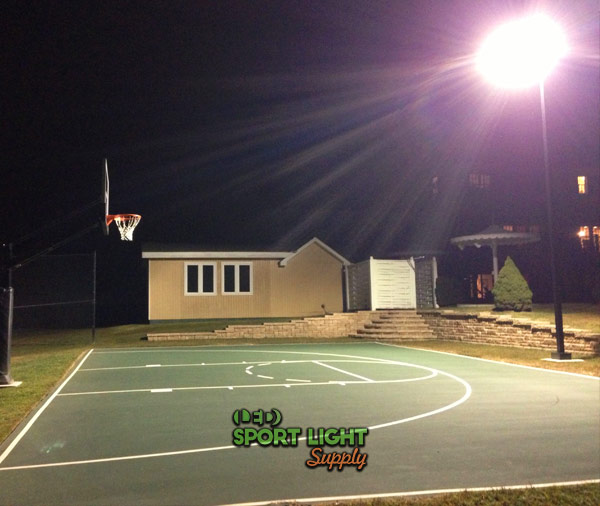Inadequate lighting can significantly increase the risk of injuries, as players might misjudge the ball’s position or their own movements, leading to collisions or falls. Additionally, poor lighting can cause eyestrain, impairing players’ ability to focus and perform optimally. This not only affects the quality of the game but can also raise concerns among spectators about visibility and security, potentially diminishing their enjoyment and satisfaction.
For basketball stadium owners, addressing lighting issues is vital for compliance and operational efficiency. Failure to fix lighting problems promptly can result in the arena not meeting regulatory lighting standards, affecting game scheduling and facility use. Moreover, broadcasters who rely on high-quality lighting for their coverage may raise concerns about visual quality, potentially leading to contractual disputes or even the termination of agreements. Investing in a well-designed and maintained lighting system is essential for safeguarding players, enhancing the spectator experience, and maintaining strong relationships with broadcasters, ensuring a successful and safe basketball environment.
Table of Contents
ToggleHow to Fix the Illuminance Level Issue on a Basketball Court
 Illuminance level refers to the amount of light present in a basketball court, whether indoors or outdoors. This can range from a few tenths of a lux under moonlight to as high as 3,000 lux for high-profile events like international games or special NBA events. Proper lighting is crucial as insufficient illumination can negatively impact players, coaches, and spectators. For instance, inadequate lighting can cause players to misjudge the ball’s position or movements, and harsh artificial lighting might distract coaches and players alike. Therefore, achieving the right amount of light on the court involves considering various factors, including the type of game and the needs of all participants.
Illuminance level refers to the amount of light present in a basketball court, whether indoors or outdoors. This can range from a few tenths of a lux under moonlight to as high as 3,000 lux for high-profile events like international games or special NBA events. Proper lighting is crucial as insufficient illumination can negatively impact players, coaches, and spectators. For instance, inadequate lighting can cause players to misjudge the ball’s position or movements, and harsh artificial lighting might distract coaches and players alike. Therefore, achieving the right amount of light on the court involves considering various factors, including the type of game and the needs of all participants.
Determining the Right Lighting Levels
In an indoor basketball arena, the luminance pattern, including the reflectance of the floor and walls, plays a crucial role in how players perceive their surroundings. Basketball associations typically set specific lighting standards based on the level of competition. For international games and major league events such as those by FIBA or the NBA, an illuminance level of 1,500 lux is required. National basketball leagues and tournaments generally require between 500 and 800 lux, while local events, high school championships, and recreational use typically need around 250 lux.

Addressing Illuminance Issues
To address illuminance issues, start by measuring the current lighting levels with a light meter. For a more comprehensive solution, particularly for televised games, consulting with an expert lighting designer is advisable. If you choose to tackle the problem yourself, check the lumen maintenance factor of your existing lights and consider replacing outdated lamps with new LED lights that have a TLCI of at least 90 or a CRI above 85 Ra. Additionally, ensure that the lighting uniformity on the playing surface meets the recommended standard of 0.7. By making these adjustments, you can enhance the visibility and overall experience of the basketball game.
How to Troubleshoot the Most Common Basketball Court Lighting Problems
In a basketball stadium, maintaining consistent and reliable lighting is essential for optimal performance and safety. However, several common issues can affect lighting quality, including flickering, broken switches, and compatibility problems. While addressing these issues may sometimes require professional expertise or equipment, there are practical steps you can take to troubleshoot and resolve these problems yourself.
Flickering Lights
Flickering lights are a frequent issue in basketball court lighting, often caused by a loose or failing bulb, or a corroded socket. This problem typically becomes noticeable when powering up the lighting system. To address flickering, start by ensuring the bulb is properly threaded into the socket. If the flickering persists, inspect the socket for corrosion or damage and replace it if necessary. For outdoor fixtures, this issue can be more pronounced due to environmental exposure.
In cases where flickering is a problem with standard LED lights, especially in settings where video recording is crucial, such as televised games, the solution involves installing flicker-free LED lights. These lights are specifically designed to prevent flicker and ensure high-quality picture and video capture.
Broken Switches
Another common lighting issue is malfunctioning switches. Over time, the internal components of a switch, such as the spring and metal tabs, can wear out, leading to flickering or complete failure of the light. Dimmer switches, in particular, may be more complex and prone to issues. Replacing defective switches is often necessary to restore proper function. Alternatively, upgrading to a modern lighting control system can provide a more efficient solution. Panel-based control systems or wireless options, such as Bluetooth, offer greater flexibility and ease of management.
Compatibility Issues
Compatibility problems arise when LED bulbs and switches are not properly matched. While LED lights are widely used due to their cost-effectiveness and energy efficiency, not all LED lights are dimmable, and not all switches are compatible with dimmable LEDs. Incompatible combinations can lead to reduced lifespan of the bulbs or strobe effects. To avoid these issues, ensure that all components—bulbs, switches, and dimmers—are compatible with each other. If necessary, replace outdated dimmers or switches with ones designed to work seamlessly with modern LED technology.

Avoiding Glare and Achieving Visual Comfort
Imagine a high-stakes basketball game where your favorite player executes a signature combo move to outmaneuver a defender. Such moments are thrilling, but if the lighting is poorly managed, they can be overshadowed by glare, affecting both players’ focus and spectators’ enjoyment. Excessive brightness can distract players and cause discomfort for viewers, making it essential to address lighting issues to ensure an optimal experience for everyone involved.
Understanding Glare
Glare can be categorized into two main types: direct and indirect. Direct glare occurs when the intensity of artificial lighting is too high within the field of view, causing discomfort and impairing visual performance. For instance, if floodlights are directed towards the spectators, they can dazzle the audience and detract from their experience. On the other hand, indirect glare arises from the reflection of high-brightness lights off polished surfaces, such as the glossy maple flooring of a basketball court. This reflected light can be equally distracting, both to players and viewers.
Managing Glare and Enhancing Visual Comfort
To mitigate glare, it’s crucial to carefully consider the direction and angle of light sources. Avoid positioning floodlights in a way that they shine directly into spectators’ eyes. Instead, angle the lights to minimize direct exposure and reduce potential glare. Additionally, using fixtures with a wide beam angle, such as a 120-degree floodlight, can help distribute light more evenly and reduce harsh contrasts.
When lighting polished surfaces, such as the basketball court floor, angle the lights to minimize reflections and ensure even illumination. By doing so, you can diffuse the light more effectively, avoiding bright spots that can cause glare. Properly designed lighting not only enhances players’ concentration and performance but also ensures that spectators can fully enjoy the game without being distracted by uncomfortable glare.
The Best Solution for a Dim Basketball Stadium
When dealing with insufficient lighting in a basketball stadium, the most effective and efficient approach is to conduct a photometric analysis. This analysis involves leveraging expert knowledge and advanced tools to assess and optimize lighting conditions. By employing professional software, spectrometers, and auxiliary sensors, lighting designers can gather detailed photometric data, ensuring that the lighting design meets the required standards and enhances the overall atmosphere of the stadium.
The Role of Photometric Analysis
Photometric analysis provides precise insights into how light interacts within the stadium. Experts use this data to determine the optimal color temperature for LED lamps, ensuring that the light is neither too warm nor too cool. Color temperature, which measures how light appears—whether warm like candlelight or cool like daylight—plays a crucial role in creating a visually comfortable environment. Inadequate color temperature can result in light that appears too bluish or yellowish, potentially affecting player performance and spectator engagement. If the lighting is not right, it may even impact the scoring average and overall excitement of the game, leading to a diminished fan experience.
Benefits of Professional Expertise
Without professional expertise, adjusting lighting conditions can be a challenging and time-consuming process. Finding the right angle and intensity for optimal luminosity requires trial and error, which can be inefficient and frustrating. Lighting professionals, on the other hand, rely on precise data and scientific formulas to determine the ideal luminous flux for your specific basketball court. Their expertise ensures that the lighting design not only meets regulatory standards but also enhances the visual experience for players and spectators alike, making every game more enjoyable and engaging.
Conclusion
Addressing dim lighting in a basketball stadium effectively requires a thorough photometric analysis conducted by experts. By leveraging advanced tools and precise data, professionals can optimize lighting conditions to achieve the ideal color temperature and luminosity. This ensures a visually comfortable environment that enhances player performance and spectator enjoyment, ultimately contributing to a more engaging and successful game experience. Investing in expert lighting solutions not only resolves immediate issues but also sets the stage for a vibrant and captivating atmosphere in your stadium.
